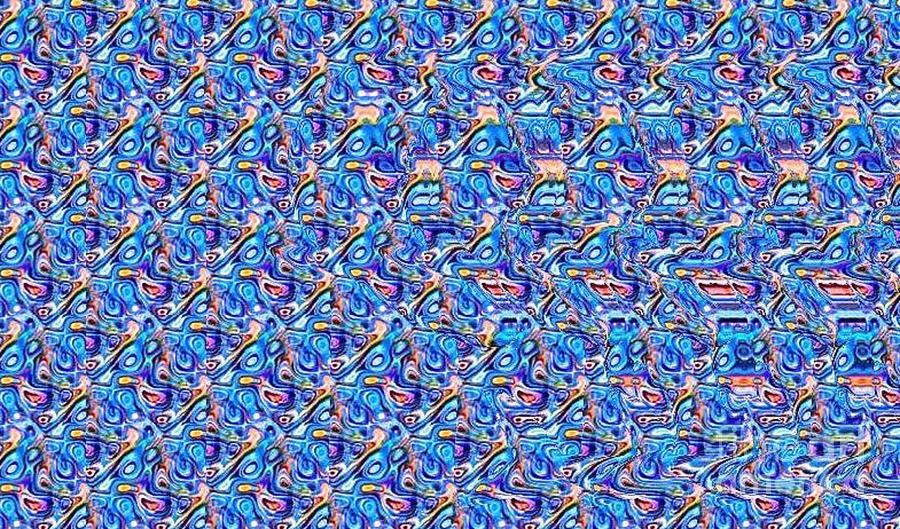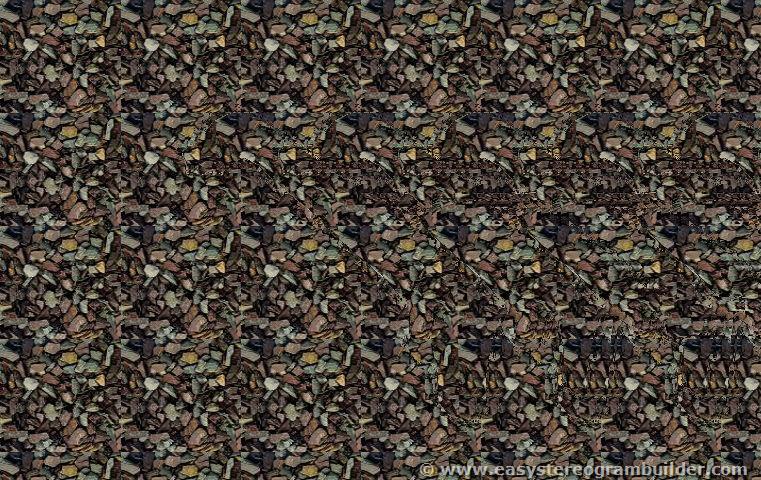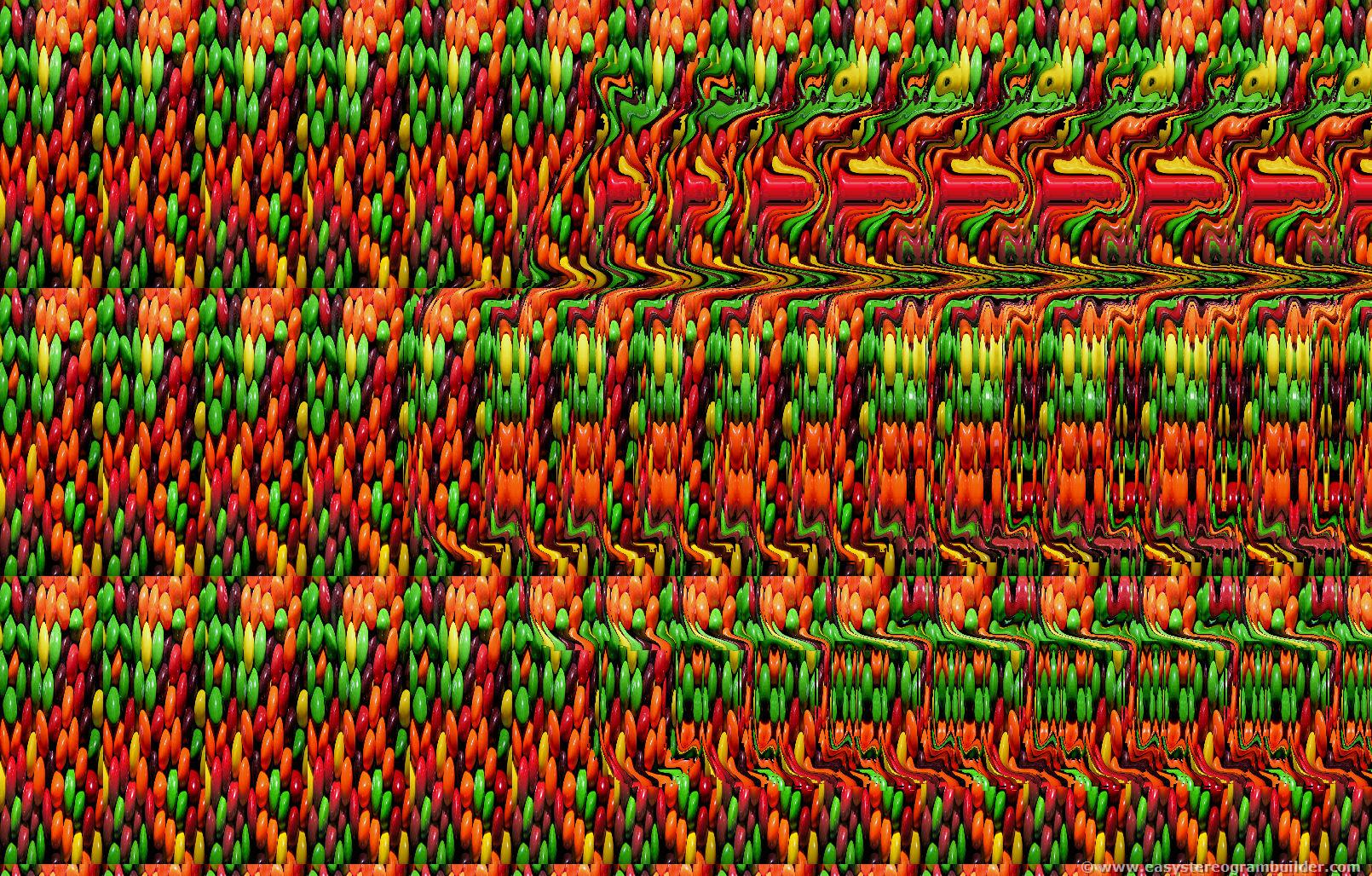- Stereograms With Answers
- Stereogrammer
- Random Dot Stereogramsemploy Either Two Stereoscopic Images Or One Anaglyph. The Input Image (or Images) Contain Random Dots With No Discernible Shapes. When The Proper Viewing Device Is Used, A Hi...
- Random Dot Stereogram
Stereograms allow you to see a three-dimensional shape while looking at a two-dimensional image. Below is a wallpaper stereogram. A holographic stereogram is created by using a series of 2D photographic images or 2D images displayed on a LCD screen from which the hologram is recorded. In order to obtain a high-quality holographic image with a large field of view, many 2D images are needed. Kitty Stereogram by 3Dimka on DeviantArt DeviantArt is the world's largest online social community for artists and art enthusiasts, allowing people to connect through the creation and sharing of art.
by W.A. Steer PhD
About...
The software around on the Internet, mine included, makes itrelatively easy to knock up some simple stereograms. Howeveran appreciation of the medium and a great deal of skill isrequired to produce truly stunning pieces of artwork. I hopethis document will open your eyes, answer some frequently-asked questions,and help you get the most out of this new art form.
This document assumes that you are familiar with the material covered inmy Introduction to Stereograms.
Introduction and Definitions
Firstly, recognise that a stereogram is built from two components:the actual 3D scene to be contained within, and the pattern used to renderit. The 3D scene may originate in any computer-format, but as far as thestereogram program is concerned, it simply needs to know the depthto be represented by each pixel on the image. It is thus convenient to passthe 3D information to the stereogram software as a 2-dimensional array ofdepths known as a depth-map, commonly in the form of a greyscalepicture where the gradations from white to black indicate increasing distance.
Diagram: A stereogram is formed by processing a pattern witha depth-map.
Sometimes you will see a depth-map called a 'bump map'. This terminologystems from C.A.D./rendering software which frequently use the concept ofa greyscale picture to describe surface textures, such as pebble-dashing.I will avoid the term 'bump map' because it is normally applied todefinitions of small variations in the surface of a larger body,rather than the complete range of depths encountered in a scene.
3D scene and depth-maps
For a stereogram to be good, it must contain an interesting 3Dscene. Accept that the amount of detail that an average person candiscern is fairly limited, so big, bold designs work best. Nevertheless,a handful of more subtle features will keep experienced viewers enthralledfor longer.Probably the most difficult part of realising a stereogram is getting agood idea for a scene into a usable depth-map. There are four mainapproaches:

- Bitmap art software
- Programs such as the Windows Paintbrush, or Paint Shop Pro can be used to manually draw shapes or text in different shades of grey, so they appear at different depths in the image. This is tedious, and generally will only result in a somewhat limited 'cardboard cutout' collage of flat shapes.
- Custom computer program
- For virtually all the depth-maps I created I wrote small custom computer programs for the task, each scene requiring a unique chunk of code. Providing you are of the programmer type, this technique works well for simple scenes which can be described geometrically or algorithmically. It is also good for plotting mathematical surfaces and may be the only way of rendering scientific data.

- CAD software
- You can build up quite complex scenes and freely change the camera angle and image size using the various C.A.D. programs, but these in turn need considerable skill, practice, and patience to use. The particular software used will determine how easy it is to output the scene as a depth-map. If there is no built in feature, they can be coaxed, by using matt white surfaces, purely ambient illumination, and black fog or 'distance cue' rendering options. An alternative is to put a lone point light source at the camera position, with shadows switched off, and linear fall-off selected. Care must always be taken to ensure the grey level varies linearly with depth, otherwise the scene will become distorted in the stereogram. Consequently features such as gamma-correct must be turned off as well. Similarly, anti-aliassing options have an undesirable effect in this application. You need to make sure the depth-map has a wide and smooth tonal range of greys, otherwise the stereogram may have very distinctive layers in place of smooth curves.
Stereograms With Answers
I'm working on software to generate depth-maps from a simple stereo pair of photographs, but this is still in a very early stage of development.
Note that the resolving power of the eye is such that it is completelyunnecessary to have more than 256 discrete levels in a stereogram depth-map.Patterns
Patterns obviously add lots of interest and set the mood of a stereogram.But never forget that all the 3D information is conveyed by the subtlevariations in the repeated pattern. A pattern lacking in fine detail - acartoon is the worst example - will fail to reproduce delicate 3D structureand the stereogram may assume an indistinct 'watery' quality. At the otherextreme, large scale structure in the pattern is essential to aid initialand sustained correct convergence of the eyes. Good contrast helps theconvergence of the eyes, but take care: a pattern which is too 'strong' oritself suggestive of 3D - containing representations of shadows, for example -is likely to detract from the hidden image. It can be difficult to predicthow well a particular pattern will work for a given depth-map, though withexperimentation you'll develop a feel for it.Ensure your audience sees what you intended
There are two common reasons why an audience may not see quite what wasintended in a stereogram:
 depths) and some means of ensuring that insertedpattern does not replicate any already used on that line.
depths) and some means of ensuring that insertedpattern does not replicate any already used on that line.A classic stereogram with artifact is Pascal'smaelstrom.gif(a minature of which is shown to the right). I find it near-impossible tosee right into the 'eye of the storm' without getting distracted by a flat,narrow vertical artifact shaped like a chimney, being broader at its basethan higher up. If you look hard, you'll notice it repeats at regularintervals across the stereogram, though in the copies the base curvestowards you quite sharply. It looks to me as if the root of the problem inthis instance was the use of a pattern which was narrower than the widestrepeat distance required, and hence repeated itself within that period(except at the shallower bottom of the picture).
A second example can be found if you look closely at another of Pascal'searly stereograms, his 'dripping tap': to the right of the tap you'll seea typical artifact, this time stemming from the depth discontinuity betweenthe tap and the background.
Thanks toPascal Massiminofor permitting me to reference his work for this purpose.
General
Resolution is everything. The greater the print resolution ofyour final stereogram the more detailed and vivid the 3D becomes.For stereograms to be viewed at reading distance to a few feet,you should aim to approach 200 to 300dpi (equivalent to theresolving power of the eye at that distance). On a practical note, anA3-size picture at 300dpi will be something like a 20Mb file!Some stereogram programs vary the repeat distance in direct proportion tothe depth to be represented. Mathematically this is not quite correct andwill lead to a mild distortion of depth, especially noticeable in very deepscenes. SISGen uses a slighly more sophisticatedrelation to achieve perfect depth scale. When combined with a depth-mapincorporating perspective an even more realistic effect is obtained.
Contrary to popular belief, the depth resolution of an autostereogram ona given display device is just as good as for other technologies suchas anaglyphs (red/green spectacles) or sequential display (alternateleft/right images on a screen, with synchronised blinking LCD spectacles).The real limitation (and reason why autostereograms will never wipe outother types of 3D) is their inherent inability to represent localisedcolour. Normal visual detail, such as colour and form, is sacrificed inorder that the stereographic (depth) information can be conveyed when botheyes see exactly the same picture. Traditional 3D uses some kind offiltering so that each eye sees a completely independent image, andthen localised detail presents no problem.
Stereogrammer
It should be remembered that a very small minority of the populationare unable to see autostereograms because of a genuine sight-difficulty,and many more don't see them because they haven't got the time - orinclination - to learn the technique. As long as you have reasonable visionand importantly a comparable quality of sight in each eye (with anyspectacles if applicable) then there is no physical reason why you cannotview stereograms. For two years my brother couldn't see them, and deniedhe ever would, then one day - it happened!
If you are really serious about stereogram-creation you should tryto understand the technical details of the method, documented inTechnical Description of my Algorithms andPrograms.
Answers to FAQs
- The stereograms I've made are so coarse - please direct me to somedepth-maps with more than 256 levels.
- If you work out the resolution of the human eye (say 300dpi at readingdistance, decreasing with increasing distance), then it is apparent thateven under best conditions and a close-viewing stereogram it would be nearimpossible to distinguish 256 linearly-spaced levels spanning the maximum'safe' range usable in a stereogram. Rather, the complaints arise becausestereograms have been produced at low resolution with no anti-aliassing.A standard computer monitor (about 70dpi) is incapable of representing morethan approximately 40 depths in a typical stereogram, though theoversampling feature in SISGen will smooth out thejumps making them barely noticeable. Of course if you really need torepresent fine detail, then a high-resolution output device is still anecessity.
- Why do you need hidden surface removal in a stereogram program?
- Failure to implement an effective hidden-surface routine will almostcertainly result in the production of artifacts in the image stemming fromregions where there is an abrupt change of depth as you move horizontallyacross the page. See the feature above on artifacts.
Last modified: 23 March 2002
Source: http://www.techmind.org/stereo/shints.html©1995-2001 William Andrew Steer
Random Dot Stereogramsemploy Either Two Stereoscopic Images Or One Anaglyph. The Input Image (or Images) Contain Random Dots With No Discernible Shapes. When The Proper Viewing Device Is Used, A Hi...
Random Dot Stereogram
andrew@techmind.org